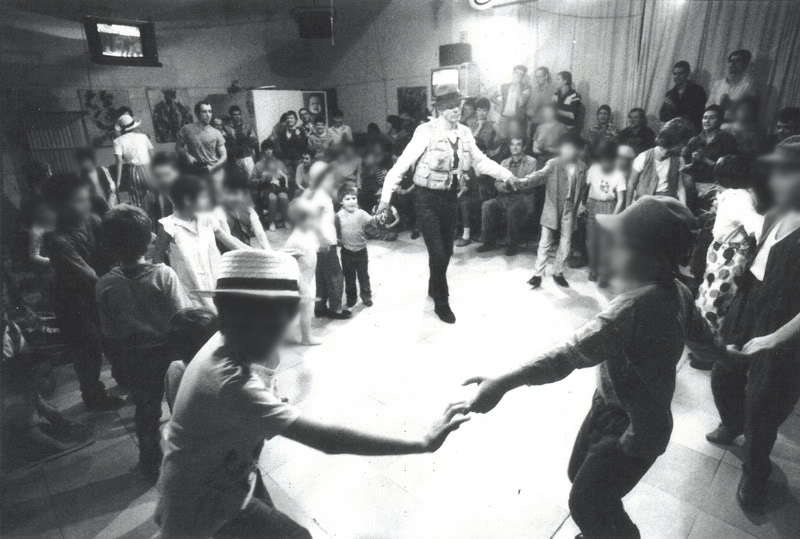Photos by Alex Binder
Satanism typically conjures thoughts of dark-cloaked figures in deeply wooded areas, where they sacrifice livestock over a makeshift altar and whisper mysterious incantations in hopes of appeasing their dark lord. Maybe every once in a while they get creative and throw a baby doll off an overpass or vandalize a Catholic church with swastika graffiti to garner a bit of attention. Chances are, however, that anyone who participates in these types of activities is also a regular at IHOP, works at a mall, and thinks Marilyn Manson is a real person.
Truly terrifying entities don’t advertise their presence, which is the main reason traditional satanic cults have eluded the public and thrived in every sector of our society. For hundreds of years, these secret organizations have relied on the simplest method to recruit and convert: fear. In fact, the only reason we are certain satanism still poses a danger is because it continues to produce victims of severe ritualistic abuse.
Claudia Fliss is a therapist and Germany’s leading expert on the aftereffects of ritualistic abuse. She has helped rehabilitate former members of satanic cults for the past two decades. Claudia has examined hundreds of correlating accounts from cult members who strayed from the flock, and the examples she gave me made the usual yarns seem like bedtime stories. For starters, victims frequently recount instances of cannibalization and the murder and rape of children. Even more disturbing was the way Claudia spoke of these events with a serene familiarity—she hears these kinds of accounts on a regular basis.
Just when I thought it couldn’t possibly get any worse, Claudia informed me that the majority of her patients were born into satanic orders and “programmed” from an early age to obey their fiendish parents and elders.
One of the initial stages of programming involves locking a child in a box and sounding a corresponding “trigger,” such as a mobile-phone ringtone or whistle. The goal is for the child to associate the noise with feelings of horror and dread, a method of control that proves to be very effective once the child is let out, which, by the way, doesn’t happen until he or she is moments away from total asphyxiation. After the lid is opened, the child is immediately instructed to do something awful like kill an animal. In most cases, the youngster refuses and is forced back inside, where he or she must wait for even longer before being hauled out again and given the same instructions. If he or she puts up a fight, it’s back in the box until the kid’s will is broken.
This process is so traumatic that the victim’s mind creates completely new and different personae (often older children or even adults) that can better cope with the agony. When the individual is finally released, he or she identifies the box opener as his or her savior and, by extension, instantaneously becomes loyal to the cult. Then, whenever senior cult members need the victim to do their bidding, all they have to do is repeat the trigger sound; the target will relive the initial traumatic experience and revert to the state he or she was in immediately after being let out of the box.
Victims of satanic ritual abuse are primarily women, and they often suffer from dissociative identity disorder as a result. It’s hard to fathom, but the number of identities within a single individual can exceed 100, and victims usually refer to themselves in the first-person plural.
After my initial interview with Claudia, she called to invite me to meet two victims and raise awareness of their conditions. Claudia also warned me that there was a large risk involved because the cult still had contact with the subjects.
Three days later, we met in a Berlin flat. Claudia introduced me to two girls who were both less than 25 years old. They were reserved and apprehensive, and chain-smoked while drinking cup after cup of coffee. We sat in a small bedroom and spoke for an hour about their experiences with the cult. The conversation would stall when my questions about satanic cults, ritualistic abuse, and sound triggers became too specific.
As they left the room, Claudia turned to me and asked whether I was aware of whom I had been speaking with. It was a weird question to be asked, so I paused for a second before she went on to explain that between the girls she had recognized at least ten distinct identities that had emerged during our conversation. After months of treating the girls, Claudia can easily recognize the nuances of different personae: the 25-year-old hyperintelligent girl, the moody 18-year-old, the mistrustful 45-year-old conservative.
The gravity of the situation was lost on me until I accompanied Claudia to the kitchen to speak in private. When I passed the girls, I noticed that they were slouched on the floor, literally saying, “Goo-goo, ga-ga.” The childlike personaes inside of them had grown tired of grown-up conversation and wanted to play with crayons.
After this first encounter, I met up with the girls on seven further occasions. During one visit, they arranged for me to meet more of the “little ones”—the young children and toddlers within their systems. We visited a Berlin park just after dawn to avoid parents and their children. The mood was apprehensive, and when they were in eyeshot of the playground a remarkable transformation took place. Both girls began speaking in children’s voices, sucking on their thumbs as they discussed which swings were still dry and safe to sit on. Over the next 45 minutes, I met approximately eight different “children.” They scaled walls, slid down slides, kicked a soccer ball, fell off a swing, and thumped around in the sand.
As we were sitting in the sand, a whistle screeched. One of the girls hid her head in her hands and began to cry. “I have to see Mommy,” she said. “I must see Mommy.” That’s when things became very dark. Calling for “Mommy,” of course, meant she was expressing a desire to return to a member of the very cult she was now attempting to escape. Claudia later explained that the whistle had triggered a persona in one of the girls.
“We’ve always been several [personae],” said one of the girls in a voice that apparently belonged to a different child than the one I was speaking with just moments before. Her friend sat there hugging herself and sobbing. The girl continued: “Even if we don’t agree on everything, we’re the only company we have.”
I asked Claudia what the girl meant. “One goal of the therapy is to establish certain personae who act as spokespeople for others within the system,” she explained. “They build up a certain trust and deal with everyday encounters. When a new identity is thrown into everyday life, it is the role of these more stable personae to calm them and explain what is going on.”
This process, called “sorting” by the girls, took a couple of minutes, and soon the small child had calmed down and was replaced by another identity. Had the girls not been capable of a staggering level of self-control, they would be back in the order now, suffering the consequences. The fact that they opened themselves up to me gave me hope that one day others might follow suit in numbers that will force the public to pay attention to their plight.
“We can’t just live our lives complaining that there is nobody really there to help us without being willing to do something about this ourselves,” one of the girls said.
Even more than the torture, psychological programming, infiltration of governmental offices, and blackmail, the biggest factor contributing to the success of satanic cults is our reluctance to believe in them in a realistic way. The German police don’t have a specific department that deals with crimes relating to satanism or ritualistic abuse, and the related crimes they do investigate are filed away in different categories and quickly disappear from the agenda. Many times, when victims make the incredible step of breaking away from cult life, the public can’t help but question their legitimacy and look for a way to discredit their stories.
As one of the girls said to me: “People don’t want to believe us because then they’d have to do something about it. I find that so cowardly.”
Then she started talking about the tattoo she was planning to get to cover the pentagram that was carved across her back. She said she was thinking of getting a dolphin.
Videos by VICE
More
From VICE
-

Leavenworth Penitentiary in Kansas. Photo by Kevin McKiernan/ZUMA Press Wire/Shutterstock. -

Children at the Friedrichshof Commune dance with renowned artist Joseph Beuys. Inka, aged four, holds his right hand. -

Image by Lovesac -

